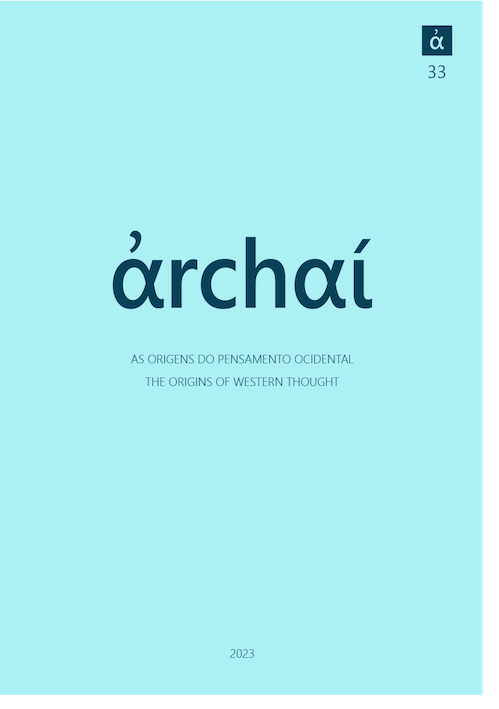Demonstration and Necessity: A short note on Metaphysics 1015b6-9
DOI:
https://doi.org/10.14195/1984-249X_33_20Keywords:
Aristotle, explanation, demonstration, necessityAbstract
I discuss a short string of five sentences in Metaphysics V.5, 1015b6-9 relating demonstration to necessity. My proposal is that Aristotle focuses his attention on the demonstration as a demonstration. Other interpretations reduce the necessity in question to the modality of the component sentences of the demonstrations (the conclusion and the premises). My view does not deny that modality of the component sentences is important, but takes seriously the idea that a demonstration itself should be understood as necessary-as not capable of being otherwise. A demonstration cannot be different from what it is in the sense that [i] its components cannot be different from what they are, [ii] its components must be related to each other exactly in the way they are related. Demonstrations aim at the fully appropriate explanation of a given explanandum-and each demonstration is individuated by the explanandum it takes. Thus, the basic idea is that, for the target explanandum that individuates a given demonstration, the premises delivering the fully appropriate explanation cannot be replaces with different ones. I show how this proposal, which explains Aristotle’s language in 1015b6-9 accurately, does not make demonstrations ‘melt down into conditional necessity’, first, because the modality of the component sentences is still importantly involved, second, because the explanatory relation expressed in a demonstration is a necessary fact in the real world, so that the demonstration itself is also necessary (in the way I have explained) inasmuch as it captures that fact.
Downloads
References
ANGIONI, L. (2016) Aristotle’s Definition of Scientific Knowledge (APo 71b 9-12). Logical Analysis and History of Philosophy 19, p. 140-166.
ANGIONI, L. (2018). Causality and Coextensiveness in Aristotle’s Prior Analytics I.13. Oxford Studies in Ancient Philosophy 54, p. 159-185.
ANGIONI, L. (2019). Aristotle’s Contrast between episteme and doxa in its context (Posterior Analytics I.33). Manuscrito 42, n. 4, p. 157-210.
ANGIONI, L. (2020). Aristóteles e a necessidade do conhecimento científico. Discurso 50, n. 2, p. 193-238.
BARNES, J. (1993). Aristotle: Posterior Analytics, Oxford, Clarendon Press.
BERTI, E. (2014). Aristote: Métaphysique Delta Paris, Librairie Philosophique J. Vrin.
BRONSTEIN, D. (2016). Aristotle on Knowledge and Learning Oxford, Oxford University Press.
DELCOMMINETTE, S. (2018). Aristote et la nécessité. Paris, Librairie Philosophique J. Vrin
FEREJOHN, M. (2013). Formal Causes Oxford, Oxford University Press .
FERREIRA, M. (2020). Συλλογισμός tem dois significados nos Analíticos?. Dissertatio 52, p. 59-89.
KIRWAN, C. (1993). Aristotle: Metaphysics Books III, V and VI, 2nd ed., Oxford, Clarendon Press .
MALINK, M. (2013). Aristotle’s Modal Syllogistic Harvard, Harvard University Press.
MENDELSOHN, J. (2019). Aristotle on the Necessity of What We Know PhD Dissertation, University of Chicago.
MIGNUCCI, M. (2007). Aristotele: Analitici Secondi Roma-Bari, Laterza.
MORAVCSIK, J. (1991). What Makes Reality Intelligible? Reflections on Aristotle’s Theory of Aitia In: JUDSON, L. (ed.). Aristotle’s Physics Oxford, Clarendon Press , p. 31-47.
REEVE, C. D. C. (2016). Aristotle: Metaphysics Indianapolis, Hackett Publishing.
ROSS, D. W. (1924). Aristotle’s Metaphysics Oxford, Clarendon Press .
ROSS, D. W. (1949). Aristotle’s Prior and Posterior Analytics, Oxford, Clarendon Press .
ROSS, D. W. (1984). Aristotle: Metaphysics In: BARNES, J. (ed.) Complete Works (Aristotle). Princeton, Princeton University Press (The Revised Oxford Translation).
Downloads
Published
How to Cite
Issue
Section
License
Copyright (c) 2023 Lucas Angioni

This work is licensed under a Creative Commons Attribution 4.0 International License.
Given the public access policy of the journal, the use of the published texts is free, with the obligation of recognizing the original authorship and the first publication in this journal. The authors of the published contributions are entirely and exclusively responsible for their contents.
1. The authors authorize the publication of the article in this journal.
2. The authors guarantee that the contribution is original, and take full responsibility for its content in case of impugnation by third parties.
3. The authors guarantee that the contribution is not under evaluation in another journal.
4. The authors keep the copyright and convey to the journal the right of first publication, the work being licensed under a Creative Commons Attribution License-BY.
5. The authors are allowed and stimulated to publicize and distribute their work on-line after the publication in the journal.
6. The authors of the approved works authorize the journal to distribute their content, after publication, for reproduction in content indexes, virtual libraries and similars.
7. The editors reserve the right to make adjustments to the text and to adequate the article to the editorial rules of the journal.



